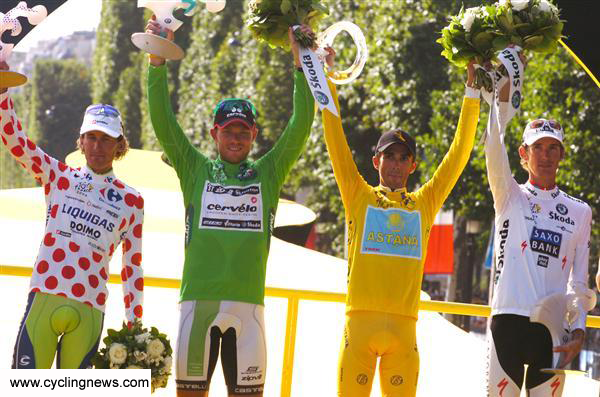February 12, 2010 by Irish Peloton
Bring back the King of the Mountains
The King of the Mountains jersey is reserved for the rider who accumulates the most points by consistently finishing well over mountainous ascents along stage routes. Unusually however, the King of the Mountains title is often won by riders who aren’t considered among the best climbers in the race. Take last year’s Tour de France for example, I think everyone would agree that there were better climbers in the race than Franco Pellizotti. Much like the Green Jersey at the Tour last year which was won by Thor Hushovd, Mark Cavendish was the best sprinter in the race, Hushovd simply accumulated the most points toward the Green jersey and was crowned the winner.
Many of the greatest climbers of all time have failed to land themselves a King of the Mountains title at the Tour, Pedro Delgado, Fabio Parra, Marco Pantani, Iban Mayo and Lance Armstrong. This is mainly due to the fact that historically, the very best climbers would also be considered among the favourites to challenge for the General Classement. To win the King of the Mountains title, a rider requires the permission of the peloton to breakaway over the Cols day after day in order to accumulate precious points. This ‘permission’ is a luxury not afforded to any G.C. favourite. Thus, the King of the Mountains title has become a jersey sought after by a B-list of climbers who are often dropped from groups containing the Tour favourites when the going gets tough.
The last real Tour contenders to win the Polka Dot jersey were Tony Rominger and Claudio Chiapucci who both won the mountains prize while finishing 2nd overall in the early nineties. Before them, it was Bernard Hinault in 1986, the year he decided to stop winning the Tour. In 1991 and 1993, Chiapucci and Rominger almost won the Polka Dot jersey by default by sticking with Miguel Indurain in the mountains and nipping ahead to collect points at the summits. Mountain points meant nothing to Indurain who was solely focused on defending his yellow jersey. In recent years, this tactic has disappeared. A rider who wishes to mop up the KOM points these days is usually so far behind on G.C. that the Tour favourites aren’t interested in wasting their own and their team’s energy in chasing them down. Michael Rasmussen used to lose large amounts of time on purpose so he could go on a ‘Chicken Run’ without garnering the attentions of the G.C. riders.

Franco Pellizotti on the podium of the 2009 Tour de France as the King of the Mountains alongside Tour winner Alberto Contador, Green Jersey winner Thor Hushovd and the best young rider Andy Schleck.
For teams who don’t have a notable G.C. contender (or in the Liquigas case last year, too many) the King of the Mountains prize is definitely worth chasing. It may not get chalked down on a list of victories for the team at the end of the season but it certainly provides the sponsors with vast amounts of exposure. The rider in the mountains jersey gets paraded on the podium at the end of each stage, he appears at the top of a race classification and he gets to race wearing a special jersey. The latter point is particularly pertinent at the Tour de France where the polka dot jersey is so strikingly recognisable. Riders like Lucien van Impe and Richard Virenque shaped their whole careers around winning the Polka Dot jersey and have since become synonymous with the King of the Mountains prize.
Nowadays however, there doesn’t seem to be many battles for the jersey at the Tour. The winner seems to take the jersey at a very early stage after being in the break of the day and the rest of the peloton seems to say ‘OK, the jersey’s yours’. The rider then spends the rest of the Tour consolidating his lead being relativley unchallenged by other riders. This was particularly the case during Richard Virenque’s run of King of the Mountains victories. There seems to be far more interest in the Points Classification which I find unusual seeing as how the resulting podium exposure is identical for both jerseys.
In shorter stage races such as Paris Nice and the Vuelta al País Vasco, the King of the Mountains jersey seems to be a happy hunting ground for young up and coming riders. In the last couple of years riders like Tony Martin, Clément Lhotellerie and Rein Taaramäe have all found success at these races. Even now, young Daniel Martin is leading the mountains classification at the Tour Méditerranéen and is likely to defend his lead given that he is over ten minutes behind the overall lead. Winning a KOM title at short stage races like these is a fantastic way for young climbers and future G.C. hopefuls to announce themselves as potential greats.
There are so many riders who target the ‘podium spots’ at the Tour and yet, winning the King of the Mountains competition also gets your photo taken atop the Tour podium in July. I hope that more and more teams will realise that the top three G.C. places is a saturated market and that aiming for the more realistic target of the Polka Dot jersey could be more beneficial. Perhaps then we’d have a real battle to watch and admire at the Tour instead of applauding a default victor who cannot be truly labelled a King of the Mountains.

Margot - March 21, 2015 @ 2:02 pm
I see you don’t use the power of social websites like pinterest and facebook on your
website. You can get big traffic from social sites on autopilot
using one useful tool, for more details search in google for:
Alufi’s Social Automation
Bev - September 13, 2016 @ 1:16 am
If you are interested in topic: earn online philippines motorcycle sidecar – you should read
about Bucksflooder first